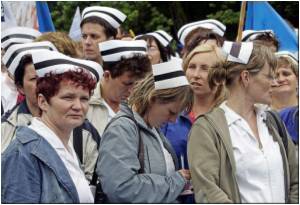Nurses in the Australian state of New South Wales have started closing down hospital beds protesting workload.

More than 150 beds have now been closed in 15 hospitals across the state and nurses say the number is set to increase dramatically.
The New South Wales Nurses Association wants an official ratio of one nurse to every four patients to be introduced, and the Health Department has until next Thursday January the 13th to respond.
The union's Wagga branch secretary, Tania Gleeson said the ratios already exist in Victoria.
She said the action is all about patient safety.
"Everyone's just had enough," said Ms Gleeson.
"I mean big picture, we're going to improve mandate hours to nurse patient ratios which improves the safety of patients when they come into our hospital."
Big branches like Westmead, St George, John Hunter, David Berry and Coonamble will decide on Thursday when they're going to start closing beds.
Despite the current action and the threats of more closures, Ms Kiejda said the union hadn't heard back from the government.
"We're still encouraging them to understand that this is a huge issue," she said.
"We believe the claim that we are putting forward for the ratios is the only way to go."
Emergency and intensive-care beds won't be affected, nor will paediatrics, maternity or oncology wards.
The union says a one-to-four nurse-to-patient ratio at most metropolitan hospitals should be included in the new award after the old one expired on June 30 this year.
The union has also put in a claim for a wage increase of five per cent per annum and a one per cent lift in superannuation.
The Acting Chief Executive of the new Murrumbidgee Health Network said she is hopeful of a resolution to the nurses dispute.
Susan Weisser said there has been a reduction in elective surgery over the Christmas break.
She says their aim is to reduce the impact on the public of the nurses action.
"We'll be working with our staff to ensure that there's minimal distruption to services," said Ms Weisser.
"And of course, services for emergency or urgent patients will continue to be available," she said
NSW Health Minister Carmel Tebbutt said on Tuesday that the government wanted to continue good-faith discussions with the union but was unable to do so in an environment of industrial action.
"The government understands that workload is an important issue for the Nurses Association and we are eager to continue our discussions around that issue," she said.
"The government does have concerns about a blunt nurse-to-patient ratio tool because it lacks the flexibility that is often needed to staff a modern hospital."
She said nurse salaries in NSW had increased by 57 per cent since the end of 1999 and the number of nurses working in NSW hospitals had increased by 10 per cent since 2005.
But opposition health spokeswoman Jillian Skinner said the government had cut hundreds of nurse positions in Sydney and the Central Coast and nurses had every right to feel "antagonistic".
"Here is the premier running around trying to stop inquiries, worrying about her members who are deserting a sinking ship and she can't ensure that our frontline hard-working nurses have a proper set of negotiations," she said.
Ms Skinner said the issue should be dealt with by the Industrial Relations Commission.
She said there was "no doubt" a coalition government would provide more nurses but said an exact number was yet to be determined because current nurse-to-patient figures were not available.
Source-Medindia
 MEDINDIA
MEDINDIA

 Email
Email



